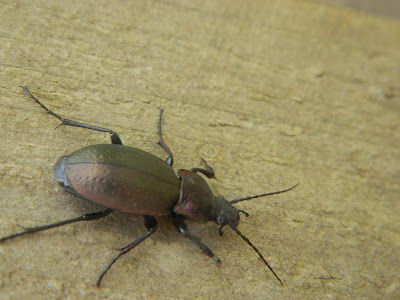Aim:
I finally completed a major garden project today. I used to have gravel walkways between my raised beds, but over time, the barrier fabric underneath stopped suppressing weeds. Last year and this spring, dandelions overtook the gravel, and their strong taproots grew straight through the fabric. Today I tore it all up and planted Corsican mint, a spreading herb that you can walk on. Added bonus: it releases minty air freshener every time you step on it.
As I was disturbing the rocks and soil and dandelions, I turned up some creatures. Notably, a fair population of roly-poly's, plus this purplish beetle.
You can see both in the picture above. I took this additional photo, mostly because I know how much you like beetles. (Don't you have a coffee-table book with photos of beetles that look like jewels?)
Although very pretty, I wonder whether the beetle is good/bad/indifferent to my garden? I found it in the pathway, not feeding on any vegetation. So, I did not kill it.
Also the roly-poly things. Again, they were in the pathway, not my actual beds. Are they detrimental, or a sign of something else that is bad?
--Rach
AnswerI'm not sure what kind of beetle that is. There are a lot of beetles. When someone asked the scientist J.B.S. Haldane what he'd learned about the Creator from studying His work, Haldane replied that God has, "and inordinate fondness for beetles." There have been over 350,000 species of beetles described (slightly more than 4 per day since we started keeping track in the 1700s). And my favorite statistic: if every plant and animal species in the world were placed in a single file line, 1 out of every 5 would be a beetle. They inhabit pretty much every habitat in the world. And, yeah, I have a coffee table book that's full of pictures of them. But I'm not very good at identifying them by sight, except for some of the usual suspects. I especially like the Clown beetles that do handstands when disturbed and aquatic whirligig beetles.
That said, I think you have some type of carabid there, which would be a good thing. The first picture looks like it has fused elytra (the hard cap on the back of the wings), which points to a carabid. There are about 40,000 species of carabids world wide, and at least 4,000 in North America. They're called ground beetles, and several species are cosmopolitan (meaning they don't seek out humans, but they thrive in areas with humans). They're primarily nocturnal, and spend the days under bark and/or rocks. Good news: if it's a carabid, it's probably eating your slugs. They hunt at night, so you wouldn't be able to see them in action unless you brought out a black light and looked for them. I might be wrong, so keep an eye on your plants. But I'm pretty sure it's a good thing you left it alone.
Roly Polys (or pill bugs or sow bugs) are often blamed by home gardeners for damage caused by other pests, because they are so ubiquitous. I was reading a forum about slug damage, and several people swore the damage was caused by these (pill or sow) bugs. Nevermind that their little mouths are waaay too small for that. They feed primarily on decaying plant matter, so you'll have them in any garden that uses a lot of compost. They're very good to have in a compost pile. They have been known to feed on seedlings, which is why some gardeners blame them for damage. If you catch something chomping away, you assume it's causing the harm you see. But unless you have a ridiculously huge population, they can't do much damage to a plant. You won't see them stripping a garden. Usually, it's the case of a sick plant (due to other culprits) where the roly polys get in on the fun. Because they feed during the day and are recognizable, people blame them. Fun fact: the scientific family name is Armadillidiidae, because they look like little armadillos. Dorky fact: I used to play bug doctor with roly polys at Grandma's house: they were sick when they curled up, and I had healed them when they started walking around on my hand.
In conclusion: I think both the beetle and roly polys are a good thing to have in the yard. Let me know if you see the beetle over by your garden, because I could be wrong in my identification. My guess is that you only saw her because you were redoing the path.












